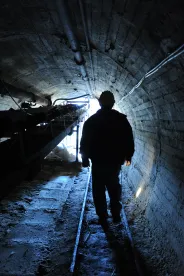Powered haulage accidents are the leading cause of fatalities in the mining industry. They accounted for 50 percent of the fatalities in 2017 and as of this writing, 57 percent of the fatalities in 2018 were powered haulage related. The Mine Safety and Health Administration (MSHA) classifies both mobile equipment and conveyor related accidents as powered haulage.
Following its review of accidents that occurred in 2017, the agency is prioritizing powered haulage safety. Last year, there were three fatalities that involved a vehicle operator who was not wearing a seat belt (there have been 35 similar fatalities since 2007) and four fatalities where a large haul truck collided with a small vehicle (there have been 23 similar fatalities recorded since 2003). Four of the fatalities that occurred in the last 12 months occurred after a miner attempted to perform maintenance on an energized conveyor or attempted to cross an energized conveyor in an unsafe location.
In light of these statistics, MSHA has increased outreach with stakeholders to identify best practices that will reduce the number and frequency of fatal powered haulage accidents. On April 3, 2018, the agency sought feedback from mine operators, miners, trainers, and safety consultants on strategies and systems they have employed to improve the safe operation of powered haulage equipment. MSHA’s request for feedback focused primarily on seat belt usage, collisions involving both large and smaller vehicles, and conveyor safety. The agency has also collaborated with mining associations to raise awareness and improve safe work practices.
On April 30, 2018, MSHA shared the feedback it received from stakeholders during its quarterly stakeholder call. While some commenters suggested that mine operators invest in technological advancements such as cameras, proximity detection systems, and seatbelt interlocks to reduce the number of fatal vehicle accidents, many suggestions focused on non-technological solutions that are accessible to both small and large mine operators such as:
- individualized training to improve awareness of blind spot distances;
- the use of high visibility strobe lights, flags, and seat belt covers to enhance vehicle detection and regulatory compliance;
- separate roadways and parking areas for small and large vehicles; and
- improved signaling and communication with heavy equipment operators.
Additionally, stakeholders suggested measures for reducing fatal accidents around conveyors. Some of these included changing the size and visibility of guards, constructing guards to eliminate removal for cleaning, strategic positioning of emergency stop cords in the event of falls, and improved positioning and sizing of conveyor crossovers to ensure they account for their need and use.
Takeaways for Mine Operators
While MSHA Assistant Secretary of Labor for Mine Safety and Health, David G. Zatezalo, stated during the quarterly stakeholder call that MSHA does not anticipate a need for additional regulation at this time to reduce powered haulage fatal accidents, such rulemaking may be possible in the future. For now, the agency is urging mine operators, miners, and trainers to identify the root cause of accidents to help target miner training and mentoring for more effective accident prevention.




 />i
/>i

